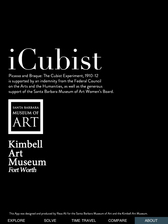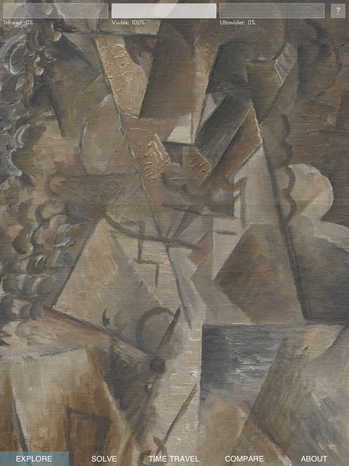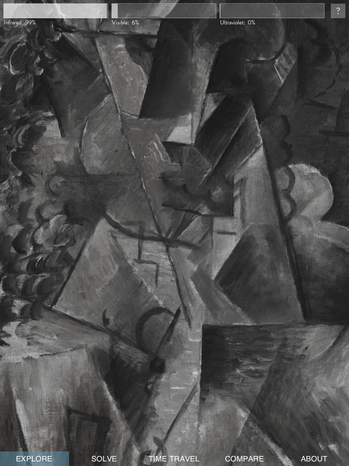 On Sunday, the Kimbell Art Museum opens its newest special exhibition, Picasso and Braque: The Cubist Experiment, 1910-1912. Ho-hum, you may be thinking. What’s new about that?
On Sunday, the Kimbell Art Museum opens its newest special exhibition, Picasso and Braque: The Cubist Experiment, 1910-1912. Ho-hum, you may be thinking. What’s new about that?
The Museum of Modern Art, for one, mounted a landmark show on the duo, Picasso and Braque: Pioneering Cubism, in 1989. It was lauded as setting the record straight on their relationship, for concluding that Braque was essential to the development of Cubism (e.g., see Michael Brenson’s review in The New York Times). What more is there to say?
Besides, that exhibition included about 400 works; the Kimbell’s (organized with the Santa Barbara Museum of Art) has 16 paintings and 20 etchings and drypoints. Case closed.
 But not so fast. The Kimbell and Santa Barbara have something up their sleeves. They focus on the two critical years, and provide new scholarship on the role of format and its representational consequences in Cubist experimentation. For example, how did the use of oval-shaped canvases play into their Cubist game? How were those compositions to be framed? The Kimbell’s oval painting was framed as a rectangle — should it have been?
But not so fast. The Kimbell and Santa Barbara have something up their sleeves. They focus on the two critical years, and provide new scholarship on the role of format and its representational consequences in Cubist experimentation. For example, how did the use of oval-shaped canvases play into their Cubist game? How were those compositions to be framed? The Kimbell’s oval painting was framed as a rectangle — should it have been?
Plus — probably more exciting for non-experts — for the past year, the Santa Barbara Museum has been working with MegaVision, a local company that makes high-quality cameras for professional, scientific, cultural and medical uses. With its digital-imaging equipment, the museums have taken “spectral images” of certain works in the exhibition. Spectral imaging can reveal features invisable to the human eye. So:
The spectral imaging created by MegaVision will be incorporated into interactive software that will allow visitors and online users to manipulate and study works with a level of detail and precision never before possible for museum audiences….this cutting-edge visual technology introduces new ways to look at and understand the processes, relationships, and stylistic developments of this important movement. Hand-held, touch-screen computers will provide mobility and interactive media content to exhibition visitors. For the first time in a museum setting, every visitor will have the opportunity to sit in front of an actual painting by Picasso or Braque and independently zoom in on the smallest brush strokes and specks of color.
 This is just one example of the new technology’s capability, the Kimbell says.
This is just one example of the new technology’s capability, the Kimbell says.
It’s no surprise that the technology is made available by a specially created iPad app, “affectionately called iCubist,” and designed by Reza Ali.
From the press release, it allows users to:
View and study works with a level of detail and precision never before possible for museum audiences….to manipulate a succession of digitized spectral images that show the artworks at different light frequencies (ultraviolet and infrared), revealing the most minute details…[and to] uncover important decisions made by the artists in developing their compositions.
Deconstruct a Cubist composition and attempt to put it back together.. [and thus] learn first-hand about the intellectual and creative processes employed by Picasso and Braque in their paintings. The physical act of moving visual elements emphasizes compositional choices made by the artists to create, for example, a sense of balance or movement. It also highlights recognizable elements and describe their significance.
Compare digital reproductions of paintings by the featured artists, Picasso and Braque, by clicking on markers that pop up to explain key aspects of their individual styles. This interactive activity will help visitors exercise connoisseurship to distinguish between the artists’ hands, despite their close similarity during the Cubist years.
Explore the history of Cubism by means of an illustrated timeline that includes vintage photography of the artists and their friends and reproductions of key works of art.
I can’t exactly show you here what you’ll see on iCubist, but the top picture is a Braque painting in visible light and the bottom one shows it in infrared. You can see the tabs that you’d be able to use if this screen were really an iPad — Explore, Time Travel, Compare, etc.
So maybe the last word on Picasso-Braque was not said all those years ago. This certainly seems like exciting technology for the exploration of paintings.
Photo Credits: Courtesy ARS/Kimbell Art Museum
